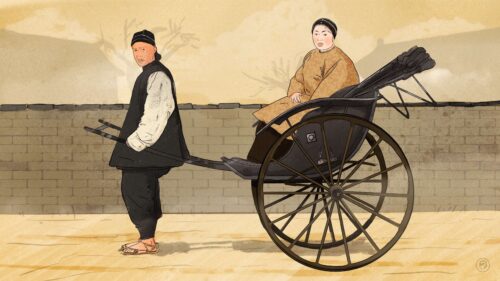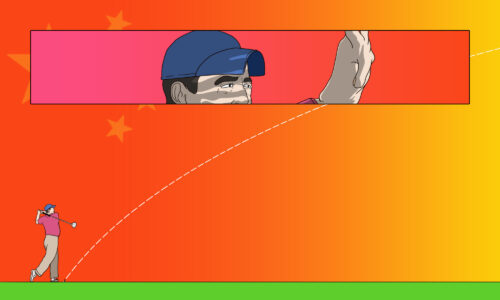This is book No. 1 in Paul French’s Ultimate China Bookshelf.
Blurbs:
“A feast of human nature for almost any reader.”
—Boston Herald
“One of the most convincing and lifelike descriptions of Chinese life we have ever had.”
—Book of the Month Club News
“No one who wants to do business in China can safely neglect it.”
—Times of London
“… a rollicking human interest story.”
—Newsweek
About the author:
Carl Crow (1884-1945) was a Missouri University-trained journalist who arrived in Shanghai in 1911 to help found the China Press newspaper. He soon branched out from newspapers into advertising, creating the most high-profile Western-style ad agency in China. From 1918, Carl Crow Inc. pioneered the use of billboards and famously popularized the use of Yuèfènpái 月份牌 — the ever-popular Shanghai calendars advertising brands while invariably featuring pictures of beautiful women. Crow covered the Xinhai Revolution of 1911 (after about three weeks in the country), helped negotiate the release of hostages in a Shandong train hijacking, wrote the first modern nationwide travel guide to China, and was a founding member of both the American Club of Shanghai and the American Chamber of Commerce in the city. He also got pretty wealthy and was one of the few Americans invited to join the snobby Brit-dominated Shanghai Club.
After the bombing of Shanghai on Bloody Saturday in August 1937, Crow was rather alarmed to find himself third on Japan’s list of the hundred most disliked foreigners in Shanghai (only the American chairman of the Shanghai Municipal Council, Stirling Fessenden, and Crow’s old newspaper pal JB Powell ranked higher in Tokyo’s disfavor). He decided to leave — threatened, his business destroyed, his home damaged by shrapnel, his health poor.
He returned to America lecturing nonstop on the plight of China under attack. During World War II he worked for the U.S. Office of Information and returned to China, flying to Rangoon, and traveling up the Burma Road to the wartime capital of Chongqing, where he experienced the Japanese “Blitz” on the city. Crow was to die in New York of cancer just weeks before Japan surrendered and Shanghai was liberated.
The book in 150 words:
In the 1930s China was experiencing a “gold rush.” People lost their heads, projecting sales to 400 million Chinese consumers. But these projections were based on “theoretical customers” and invariably resulted in disappointing losses. Using examples — cosmetics, cigarettes, pharmaceuticals, automobiles — Crow shows how the tastes of a small group of urban consumers were projected onto the wider society, throwing up enormous projections for future profits. Markets got flooded, products imitated, copyright rampantly ignored. Business costs, logistical messes, and discounting demands were underestimated and overcapacity became the norm. Crow described the China market of the 1930s as one of “long receivables, rigid markets, structural inefficiency, impossible logistics and relentless brazen copying and substitution of imported goods with fakes.” Of course there were successes — tinned milk and Kodak cameras, for example — but overall, Crow concluded, “It is to be hoped that manufacturers had a lot of fun out of their ventures because they didn’t make much money.”
Your free takeaway:
So long as people of one country make goods to sell to others, so long as ships cross the ocean and international trade exists, the golden illusion of the sales which may be made to China’s industrious millions will always be an intriguing one. No matter what you may be selling, your business in China should be enormous, if the Chinese who should buy your goods would only do so.
At one time or another, almost every conceivable kind of merchandise has been shipped to China on the off chance that some use would be found for it and that a market would be built up.
Business deals in China are always full of surprises, because, until the transaction is finally concluded and the goods and services paid for and consumed or performed no one can ever be quite sure that all the details of the transaction have been settled and that there will be no misunderstandings.
Every now and then we are visited in Shanghai by an export manager, usually a new one, who appears to be spending his company’s money on an expensive trip around the world for the sole purpose of discovering how many points of superiority he and others of his nationality enjoy over the people of the country he is visiting.
Why this book should be on your China bookshelf:
Carl Crow is a good place to start The Ultimate China Bookshelf. Were he still with us, Crow would undoubtedly be a China Project subscriber, a witty and entertaining guest on the Sinica Podcast, and a slightly acerbic observer of Sino-American relations on Twitter.
Each new entrant to the Ultimate Bookshelf needs to illustrate one major point that is key to an understanding of China. Crow’s 400 Million Customers is of course about the specific business circumstances pertaining at a given moment in China’s history — the interwar, or Republican, period. Reading it today is a useful reminder that several later generations of the foreign business community have had to relearn old mistakes, often in a very costly way.
But the primary importance of Crow is in reminding us to work hard to maintain a collective memory of China’s past, something the foreign business, academic, and China-watching communities (in all their problematic forms) have not been especially good at. The succession of the Second Sino-Japanese War, World War, Civil War, revolution, Maoism, tentative reform, repression, and restarted reforms combined meant that by the 1990s Crow and his lessons were forgotten. All the mistakes he outlines in 400 Million Customers were made again, the lessons punishingly relearnt. A stronger collective memory would have made this a less painful process.
The author himself hits all the notes that so many authors on the Ultimate China Bookshelf do. On the plus side, Crow was a man genuinely fascinated by China and the Chinese people. He felt strongly that a world well-informed about China was a safer and more mutually profitable planet. As an American he identified what he thought was a commonality in Sino-American entrepreneurial spirit and the mutual embrace of republicanism. Crow was also clearer than most foreign observers in believing that China was generally on the right side of history in the 1930s. The Nationalist government was far from perfect, but, despite this, he thought that it should have been supported against obvious Japanese aggression. Like the best writers, he looked beyond his own immediate base in privileged semi-colonial Shanghai and made the effort to travel regularly throughout the country, regularly journeying up the Yangtze to Chongqing and Sichuan, north to Beijing and down the coast south to Guangzhou. Along the way he wrote a half-dozen editions of his still-fascinating The Traveler’s Handbook for China (first published in 1913).
But Crow also shows us some of the faults that plenty of authors on the Ultimate Bookshelf invariably suffer from. He was lax in his language learning and never really put in the hours, while also having initially, as with so many journalists over the decades, presented himself as something of an instant expert. And, as history moved fast, he was doomed to go out of date almost immediately. Despite all the success of 400 Million Customers, the translations (two dozen languages), special editions, book club offers, universal reviewer praise, the book was largely forgotten just two years later as war totally swept away the China market Crow had described, not to return for over half a century. In 1937 he was a bestseller, writing op-eds, giving sell-out talks all over the country, regularly on the radio. But by 1940 the book was ancient history and wouldn’t become relevant again until arguably the 1990s, 50 years after its author’s death.
Ah, the sweet and oft-repeated agony of the China book — five-star reviews, a week on the New York Times bestseller list, a year pontificating on the talks circuit, and then…remaindered, forgotten, and only a disappointing royalty check in the post. As Crow shows, thus was it ever when competing for space on the China bookshelf.
And, as is invariably the way with commentators on China, Crow was popular with many, but he had his detractors too. Some of the foreign press corps thought him overly sensitive to Chinese concerns when vehemently opposing their commonplace use of the term “Chinaman.” The boosters at the Shanghai American Chamber of Commerce thought him too negative in 400 Million Customers. The U.S. Embassy worried he was being alarmist about Japanese aggression toward China.
Carl was of course right on all these issues. “Chinaman” is insulting and vulgar (he led a campaign to get both the OED and Merriam-Webster to cease using the term). He was the first to suggest everything in the China market was not always rosy, and that argument has never won friends in high places. And, in June 1937, the U.S. Embassy did write to Crow asking him to tone down his comments on Japanese aggression in China. He exaggerated, they argued. In July, Japan occupied Beijing. In August, they bombed Shanghai. And in September, Japan “raped” Nanjing.
Nobody ever wrote to apologize to him.
Next:
Next time we skip over 50 years to the genesis of the modern China market and another book that challenged the comfortable idea that China was a gold mine that never ceased to give treasure to all who came and staked a claim. You could succeed, but you needed deep pockets and the ability to adopt the old saying, “If at first you don’t succeed, try, try again.” Like Crow’s 400 Million Customers, it caused a stir; some got quite angry, blood boiled in fact, to a point where insults were slung around in hotel ballrooms! But, like Crow’s book a half-century previously, to which it looked at for inspiration, it told a truth difficult and unwelcome to hear for many.
Check out the other titles on Paul French’s Ultimate China Bookshelf.







